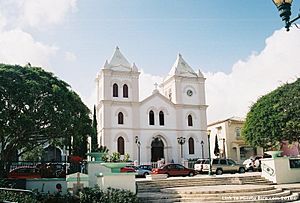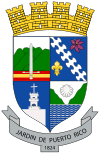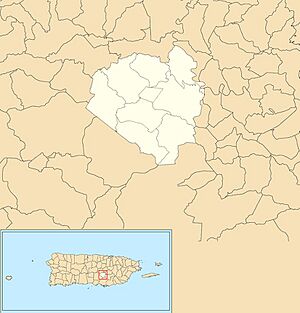Aibonito, Puerto Rico facts for kids
Quick facts for kids
Aibonito
Municipio Autónomo de Aibonito
|
|||
|---|---|---|---|
|
Town and municipality
|
|||
 |
|||
|
|||
| Nicknames:
"La Ciudad de las Flores", "La Ciudad Fría", "El Jardín de Puerto Rico", "La Nevera De Puerto Rico"
|
|||
| Anthem: "Aibonito" | |||

Map of Puerto Rico highlighting Aibonito Municipality
|
|||
| Sovereign state | |||
| Commonwealth | |||
| First settled | 1630 | ||
| Founded | March 13, 1824 | ||
| Founded by | Manuel Velázquez | ||
| Barrios | |||
| Area | |||
| • Total | 82 km2 (31.5 sq mi) | ||
| • Land | 82 km2 (31.5 sq mi) | ||
| • Water | 0.01 km2 (0.0 sq mi) | ||
| Elevation | 731 m (2,401 ft) | ||
| Population
(2020)
|
|||
| • Total | 24,837 | ||
| • Rank | 48th in Puerto Rico | ||
| • Density | 304.4/km2 (788.5/sq mi) | ||
| Demonym(s) | Aiboniteños | ||
| Time zone | UTC−4 (AST) | ||
| ZIP Codes |
00705, 00786
|
||
| Area code(s) | 787/939 | ||
| Major routes | |||
Aibonito (pronounced eye-boh-NEE-toh) is a small mountain town and municipality in Puerto Rico. It is located in the Sierra de Cayey mountain range. Aibonito is known for its cool climate. Its main square is the highest on the island, at 2,401 feet above sea level.
Aibonito is surrounded by other towns. To its north are Barranquitas and Comerío. To the south is Salinas. To the east are Cidra and Cayey. To the west is Coamo. The town is divided into 8 main areas called barrios, plus the downtown area known as Aibonito Pueblo.
Contents
- What's in a Name? Aibonito's Story
- A Glimpse into Aibonito's Past
- Exploring Aibonito's Geography
- People of Aibonito
- Fun Things to See and Do in Aibonito
- Aibonito's Culture and Fun Events
- How Aibonito Makes a Living
- What's New in Aibonito?
- Getting Around Aibonito
- Aibonito's Symbols
- Famous People from Aibonito
- Images for kids
- See also
What's in a Name? Aibonito's Story
The name Aibonito might come from a mix of Spanish and Taíno words. It could be from Hatibon or Jatibon, which was the native name for the Aibonito River. Jatibon probably meant "black river" or "night river". This name was then made smaller in Spanish to Jatibon-ito.
There's also a cool legend about the name. In 1615, a Spanish soldier named Diego Alvarez reached a high peak. When he saw the amazing view, he supposedly shouted, "¡Ay, qué bonito!" This means "Oh, how pretty!" This phrase might have later become the town's name.
Aibonito has some fun nicknames too! It's called Ciudad de las Flores ("City of Flowers") and Jardín de Puerto Rico ("Puerto Rico's Garden"). This is because of its many flower farms and a big annual flower festival. It's also known as Ciudad Fría ("Cold City") and Nevera de Puerto Rico ("Puerto Rico's Refrigerator"). This is because Aibonito has recorded some of the lowest temperatures on the island.
A Glimpse into Aibonito's Past
Before the Spanish arrived, it is believed that the Taíno lived in this area. Their settlements were part of the lands ruled by Cacique Orocobix.
Later, around 1630, a ranch was set up by Pedro Zorascoechea. This helped a small village to grow. However, Aibonito wasn't officially recognized as a town until 1824. Don Manuel Veléz asked the government for this, and Governor Don Miguel de la Torre approved it on March 13, 1824. The first Catholic church was built in 1825. The church you see today was started in 1887 and finished in 1897. After the town was official, different neighborhoods, called barrios, began to form.
Aibonito's Role in the Spanish-American War
In 1898, during the Spanish–American War, an important battle happened near Aibonito. About 800 Spanish and Puerto Rican soldiers were positioned on Asomante Mountain. They were able to stop the American troops who were trying to advance. This fight ended when the Spanish government surrendered on August 12, 1898. The soldiers at Asomante never actually gave up their position. They only stopped fighting because the war had officially ended.
After the war, Spain gave Puerto Rico to the United States under the Treaty of Paris of 1898. Puerto Rico then became a territory of the United States. In 1899, the first count of people in Puerto Rico showed that Aibonito had a population of 8,596.
Facing Nature's Challenges
On September 20, 2017, Hurricane Maria hit Puerto Rico. It caused many landslides in Aibonito due to heavy rain. Around 1,500 homes were either completely or partly destroyed. The hurricane also badly damaged Aibonito's chicken farms, killing almost 1.8 million chickens. Aibonito is famous for its flower industry and its annual flower festival, which started in 1969. Sadly, Hurricane Maria completely wiped out the flower farms.
Exploring Aibonito's Geography
Aibonito is located in the Sierra de Cayey mountains, which are part of Puerto Rico's Central Mountain Range. It is the town with the highest elevation in Puerto Rico, sitting 2,401 feet above sea level. Some of its notable mountains include La Sierra (2,394 feet), Asomante (2,042 feet), and Buena Vista (2,042 feet).
Aibonito's Neighborhoods (Barrios)
Like all towns in Puerto Rico, Aibonito is divided into areas called barrios. The main town area, with the municipal buildings, central square, and large Catholic church, is called "el pueblo" (the town).
Here are the barrios of Aibonito:
Smaller Areas: Sectors and Special Communities
Within the barrios, there are even smaller local areas called sectores (sectors). These can be different types of neighborhoods.
There are also "Special Communities of Puerto Rico" (Comunidades Especiales de Puerto Rico). These are communities that face challenges and need extra support. Some of these communities in Aibonito include parts of Algarrobo barrio, El Campito, El Coquí, and La Españolita.
Rivers of Aibonito
Several rivers flow through Aibonito. These include the Río de Aibonito, Río Cuyón, Río de la Plata, and Río Usabón.
Aibonito's Cool Climate
Aibonito has a mild tropical rainforest climate. This is because of its high elevation and its location. The town is directly exposed to the wind and moisture from the Trade Winds. This means it gets more rain throughout the year than coastal areas. Fog is also very common.
Aibonito holds the record for the lowest temperature ever recorded in Puerto Rico. It was 40°F (4°C) on March 9, 1911. The highest temperature ever recorded was 98°F (37°C) on September 29, 1920. Aibonito is known as one of Puerto Rico's coolest towns.
| Climate data for Aibonito (1991–2020 normals, extremes 1906–present) | |||||||||||||
|---|---|---|---|---|---|---|---|---|---|---|---|---|---|
| Month | Jan | Feb | Mar | Apr | May | Jun | Jul | Aug | Sep | Oct | Nov | Dec | Year |
| Record high °F (°C) | 91 (33) |
90 (32) |
92 (33) |
93 (34) |
92 (33) |
91 (33) |
95 (35) |
94 (34) |
98 (37) |
94 (34) |
92 (33) |
92 (33) |
98 (37) |
| Mean maximum °F (°C) | 77.3 (25.2) |
77.9 (25.5) |
80.3 (26.8) |
81.5 (27.5) |
82.9 (28.3) |
84.3 (29.1) |
84.5 (29.2) |
84.6 (29.2) |
84.6 (29.2) |
83.5 (28.6) |
80.5 (26.9) |
78.1 (25.6) |
86.3 (30.2) |
| Mean daily maximum °F (°C) | 73.8 (23.2) |
74.5 (23.6) |
75.8 (24.3) |
77.9 (25.5) |
79.6 (26.4) |
81.4 (27.4) |
81.4 (27.4) |
81.7 (27.6) |
81.2 (27.3) |
79.9 (26.6) |
77.1 (25.1) |
74.7 (23.7) |
78.3 (25.7) |
| Daily mean °F (°C) | 67.8 (19.9) |
68.0 (20.0) |
68.8 (20.4) |
70.7 (21.5) |
72.7 (22.6) |
74.4 (23.6) |
74.7 (23.7) |
75.0 (23.9) |
74.7 (23.7) |
73.7 (23.2) |
71.5 (21.9) |
69.2 (20.7) |
71.8 (22.1) |
| Mean daily minimum °F (°C) | 61.9 (16.6) |
61.5 (16.4) |
61.7 (16.5) |
63.4 (17.4) |
65.8 (18.8) |
67.5 (19.7) |
67.9 (19.9) |
68.4 (20.2) |
68.1 (20.1) |
67.5 (19.7) |
65.9 (18.8) |
63.7 (17.6) |
65.3 (18.5) |
| Mean minimum °F (°C) | 57.5 (14.2) |
57.8 (14.3) |
57.8 (14.3) |
59.1 (15.1) |
62.4 (16.9) |
63.8 (17.7) |
64.4 (18.0) |
64.7 (18.2) |
64.3 (17.9) |
63.8 (17.7) |
61.8 (16.6) |
60.0 (15.6) |
55.7 (13.2) |
| Record low °F (°C) | 43 (6) |
43 (6) |
40 (4) |
45 (7) |
50 (10) |
51 (11) |
55 (13) |
54 (12) |
51 (11) |
48 (9) |
46 (8) |
47 (8) |
40 (4) |
| Average precipitation inches (mm) | 3.75 (95) |
3.00 (76) |
3.51 (89) |
4.43 (113) |
5.54 (141) |
3.13 (80) |
4.65 (118) |
5.54 (141) |
9.43 (240) |
7.95 (202) |
6.72 (171) |
4.14 (105) |
61.79 (1,569) |
| Average precipitation days (≥ 0.01 in) | 16.4 | 13.7 | 11.8 | 12.0 | 13.7 | 11.3 | 13.8 | 14.4 | 15.0 | 16.0 | 16.2 | 16.6 | 170.9 |
| Source: NOAA | |||||||||||||
People of Aibonito
| Historical population | |||
|---|---|---|---|
| Census | Pop. | %± | |
| 1900 | 8,596 | — | |
| 1910 | 10,815 | 25.8% | |
| 1920 | 13,264 | 22.6% | |
| 1930 | 16,361 | 23.3% | |
| 1940 | 16,819 | 2.8% | |
| 1950 | 18,191 | 8.2% | |
| 1960 | 18,360 | 0.9% | |
| 1970 | 20,044 | 9.2% | |
| 1980 | 22,167 | 10.6% | |
| 1990 | 24,971 | 12.6% | |
| 2000 | 26,493 | 6.1% | |
| 2010 | 25,900 | −2.2% | |
| 2020 | 24,637 | −4.9% | |
| U.S. Decennial Census 1899 (shown as 1900) 1910-1930 1930-1950 1960-2000 2010 2020 |
|||
The population of Aibonito has changed over the years. In 1900, there were 8,596 people. By 2020, the population was 24,637.
Fun Things to See and Do in Aibonito
Aibonito has many interesting places to visit.
Historical Landmarks and Scenic Views
- The Old Encanto Theater and Moscoso Pharmacy show off old building styles.
- The Mirador Overlook offers amazing views of the Plata Valley.
- The Degetau Stone is where a famous writer, Federico Degetau, found his ideas.
- You can visit the Casa Museo Federico Degetau, which is his restored house.
- The San José Church was built in 1898 and is in the main town square.
- The Asomante Memorial has a plaque remembering the 100th anniversary of the Spanish-American War. It also offers great views of the mountains.
- The Asomante Trench is where part of the Spanish-American War battle took place.
- The main square is named after Segundo Ruiz Belvis, a hero who fought to end slavery.
- The San Cristóbal Canyon is a huge, nine-kilometer-long canyon with beautiful waterfalls. It is located between Aibonito and Barranquitas.
- In the Robles barrio, there's an old iron bridge built in 1892.
Festivals and Local Tourism
- The annual Aibonito Festival of Flowers is celebrated every June. Many people visit to see the huge displays of different flowers.
- To encourage tourism, the Puerto Rico Tourism Company started the Voy Turistiendo (I'm Touring) campaign. Aibonito's page in the passport book lists places like Mirador Piedra Degetau and Meyer's Nurseries for agritourism. It also suggests routes like the Ruta de Las Flores (Flower Route) and Ruta del Pollo (Chicken Route).
Aibonito's Culture and Fun Events
Sports in Aibonito
Aibonito once had a professional basketball team called the Polluelos de Aibonito. In 1986, they won their only championship! They also had a Double AA baseball team, also called Polluelos de Aibonito, which won a championship in 1966.
Festivals and Events
Aibonito celebrates its patron saint festival, Fiestas Patronales de Santiago Apostol, in late July or early August. This is a religious and cultural event with parades, games, local crafts, rides, food, and live music. Famous artists like Ismael Miranda have performed there.
The Aibonito Festival of Flowers is a very popular event held between late June and early July. People from all over come to see the amazing flower displays. Aibonito also celebrates the Festival de la Montaña (Mountain Festival) in November.
How Aibonito Makes a Living
Agriculture and Business
Aibonito is known for its farms, especially for tobacco and coffee. It's also famous for its flower farms. A well-known chicken producer in Puerto Rico, To-Ricos, has its operations in Aibonito.
Baxter International, a company that makes medical tools for hospitals, has one of its factories here.
Other Industries
Other businesses in Aibonito include factories that make clothing, furniture, and tapestry. There are also places that make pottery and ceramics.
What's New in Aibonito?
In 2014, the mayor of Aibonito, William Alicea Pérez, shared that many improvements were being made. New projects included an assisted living center and a stadium. There were also plans for a new gym and other improvements to the town center. A boxing and martial arts gym is being built with help from Puerto Rican boxing champion Miguel Cotto.
Getting Around Aibonito
There are 15 bridges in Aibonito, helping people travel around the municipality.
Aibonito's Symbols
Aibonito has its own official flag and coat of arms.
The Aibonito Flag
The flag of Aibonito has four equal horizontal stripes: blue, white, red, and yellow. On the left side, there's a green triangle with the town's coat of arms on it.
The Aibonito Coat of Arms
The coat of arms is a shield with four sections.
- The top left shows Asomante Mountain with a sword. This represents the last battles of the Spanish–American War that happened there.
- The top right has a white band on a blue background. This stands for the fog that often covers the area in winter. On each side of the band, there's a purple flower and a golden lily.
- The bottom left has a gold tower, symbolizing the spiritual importance of the Casa Manresa institution.
- The bottom right shows a green mountain, representing the San Cristóbal Canyon. Above it is a seashell, which symbolizes Apostle James.
Famous People from Aibonito
- Obie Bermudez, artist
- Rubén Berrios Martínez, politician
- Rafael Pont Flores, journalist
- Eliu Rivera, New Jersey politician
- Ramón Vázquez, baseball player and coach
- Orlando Rosa, 1996 Olympian Freestyle Wrestling
- Christopher Rosario, Connecticut State Representative
Images for kids
See also
 In Spanish: Aibonito para niños
In Spanish: Aibonito para niños











